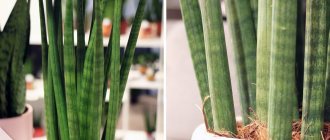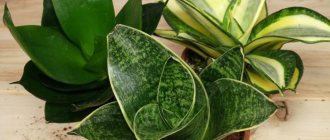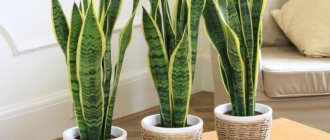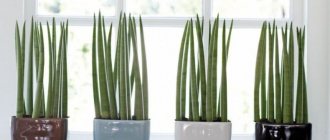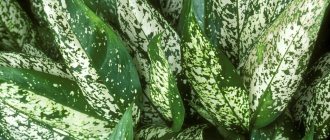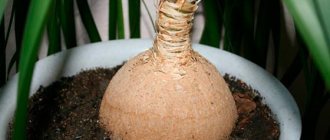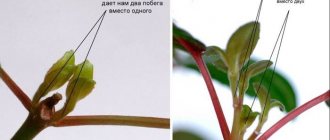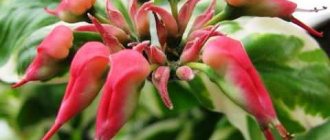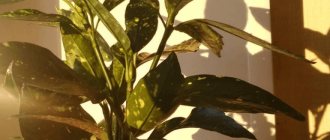What does Sansevieria cylindrical look like, what family does it belong to?
Sansevieria cylinder or cylindrical (Sansevieria Cylindrica) is popularly called simply - Pike tail. The plant of the Asparagus family is characterized by long, tube-shaped leaves that grow directly from the ground. They are very smooth to the touch and shiny due to the fact that they are covered with a dense wax layer.
The cylindrical species of Sansevieria has leaves wrapped in a tube.
Common varieties
The most famous and popular varieties of this type of plant are:
- Sansevieria Velvet Touch - got its name because of the velvety-to-the-touch stems.
- Sansevieria Bacularis is a bush with dense dark green tubular leaf blades that do not close on the stem, but grow from the ground.
- Sansevieria Skyline - has smooth and shiny leaves with dark stripes.
- Sansevieria Twist - can grow up to 50-60 centimeters, according to the external description it is very similar to the cylindrical appearance.
- Sansevieria Spaghetti - leaves are rounded, with small grooves along their entire length.
- Sansevieria Mikado is a very rare variety with thick, fleshy leaves and dark green vertical lines on them.
Medicinal properties
The great advantage of Sansevieria is that it has medicinal properties:
- normalizes blood pressure;
- improves the overall well-being of the body and strengthens the immune system;
- treats colds;
- used externally to treat inflammation and other skin diseases;
- normalizes the functioning of the gastrointestinal tract.
Briefly about the history of appearance
The plant is native to South Africa. At the beginning of the 20th century, Sansevieria was exported to Europe, from where it migrated as an indoor flower to the rest of the world.
Useful qualities of sansevieria
Sansevieria secretes substances that absorb carbon dioxide and release oxygen, especially at night. This makes them ideal houseplants. However, since the leaves are potentially poisonous if ingested, Sansevieria is not recommended for children's bedrooms.
All species of the plant are believed to act as good air purifiers, removing toxins (such as formaldehyde, xylene and toluene) from the air, thereby gaining a reputation as a good treatment for sick building syndrome.
Features of plant care at home
It is easy to care for cylindrical sansevieria; the main thing is to create certain climatic conditions in the room where it grows.
Temperature
Sansevieria - home care and reproduction
The most comfortable temperature for a flower is +10... +25 degrees. The bush normally tolerates a sharp cold snap, but in hot weather it is better to place the pot in ventilated areas.
Lighting
The flower has no special requirements for lighting. It is better to keep it in diffused light so that the sun's rays cannot burn the fleshy decorative leaves of the sansevieria.
Watering
During the growing season, the bush needs to be watered once every 7-10 days, but during the dormant period it is enough to lightly moisten the soil once a month.
Important! During wintering, it is better not to water the soil, but to spray it with a spray bottle, but avoid getting water on the ground part of the flower.
Spraying
Caring for sansevieria does not require a spraying procedure. This can cause leaves to rot due to water getting into the axils. It is better to wipe the plates with a damp cloth.
Humidity
It is advisable to keep humidity levels at an average level. If necessary, you can increase it by adding water to the pot tray.
Priming
The flower prefers slightly acidic soil. The substrate can be prepared at home. To do this, you need to mix loose soil, sand and a small amount of humus.
It is better to purchase a substrate for a flower in a store.
Feeding
To fertilize the plant, you need to choose special complex mineral fertilizers intended for succulents. The soil needs to be constantly replenished with potassium and phosphorus.
Note! When feeding a plant with fertilizers containing a large amount of nitrogen, its leaves lose their variegated color and become monochromatic.
Basic rules of care
This variety of sansa belongs to the category of unpretentious houseplants. Just protect it from direct sunlight, which can cause burns on the surface of the leaves. In the warm season, the most comfortable air temperature for her is 18-25 degrees Celsius. In the autumn-winter period, create a cooler temperature, about 14 degrees. This plant is absolutely indifferent to air humidity. Spray it only to remove dust.
In addition, Sansevieria cylindrica has the property, rare for house plants, of not reacting to drafts. Therefore, in the summer, feel free to leave a pot with this flower on the balcony, but not in the rain. The fact is that sansa does not tolerate waterlogging of the soil. As a result, its root system quickly rots and the plant soon dies. Water it only when the top layer of soil is completely dry. Pour water in a thin stream along the edge of the pot.
When and how does it bloom
Sansevieria Hanni - home care
The flowering of Sansevieria cylindrical goes almost unnoticed. The inflorescences are brush-shaped and are located on a long and erect peduncle. It is the same in length as the leaves of the flower, but sometimes it is longer. Small flowers with white-cream petals are tubular in shape. Some varieties have pale pink flowers.
The bush blooms for only about a week. Already 5-8 days after the buds open, they begin to close back and fall off.
Blooming sansevieria
Most common types
About 70 species of Sansevieria are found in the wild.
For home cultivation, less than ten are used: Sansevieria three-stripe - dense, evenly erect leaves of a delicate emerald color with dark stripes, they are located horizontally, with golden edges.
Sansevieria Craig - extensive flattened leaf plates of short length, pointed upward, in a soft amber or white color, with vertical greenish streaks applied to them.
Sansevieria Duneri – thin, evenly erect, pico-shaped leaves, up to 40 cm. They are pale with dark olive streaks.
Sansevieria Chanii - leaf blades are fat, small and extensive, triangular in shape and deep green in color. The upper part is painted with horizontal soft green or yellow strokes. Some varieties have a bluish bloom or orange edges.
Sansevieria Kirka – the surface of the dense olive pico-shaped leaves is covered with uneven white or pale light green blotches. The leaf length is about 1.5 meters.
How does Sansevieria cylindrica reproduce?
This species can reproduce in several ways, all of which are easy to use.
Germination of seeds
Mother-in-law's tongue flower - home care
Reproduction of Sansevieria cylindrical by sowing seeds is practically not used in home floriculture. Sow seeds in boxes with substrate for succulents. They need to be deepened by 1-2 centimeters. Then pour and cover with film. In a month the first shoots will appear.
Rooting cuttings
To propagate the plant by cuttings, you need to cut a part from the side leaf about 10 centimeters long. The cuttings are buried in a box with soil mixture, watered and covered with film.
Important! To prevent the plant from getting sick, the cut areas are treated with activated charcoal or charcoal.
Propagation by cuttings
Air layering
It is possible to propagate a flower using secondary rosettes; this method is similar to rooting lateral layers. In the spring, the rosettes are separated from the bush and planted in a separate pot.
How to care
— The soil must be nutritious. And it can consist of compost, humus soil and sand (1:1:2). Or turf, humus, leaf soil and sand (2:1:1:1). But you can purchase ready-made soil for succulents. The root system of Sansevieria is located in the top layer of the earth, so the container for planting is chosen to be flat and wide.
- Landing. Before planting, we inspect the plant for damaged shoots, leaves, and pests. Carefully remove the plant from the planting pot and plant it together with a lump of earth in a pre-prepared pot. At the bottom there should be a layer of drainage. The top layer should be at the level of the pot. Carefully add soil, tamp it lightly, trying not to damage the roots. Water generously and top up the soil if necessary.
— The plant needs to be replanted only as needed, when the pot becomes small. To avoid waterlogging, the pots are filled a quarter full with drainage material: clay shards, gravel. There should be nutritious soil on top.
Possible problems in cultivation and diseases
Sansevieria practically does not suffer from pests and diseases, but occasionally problems still arise.
The flower sheds buds and leaves
Most often this occurs due to dry indoor air. Sometimes a flower simply lacks some minerals in the soil.
The leaves are turning pale
This condition occurs due to a lack of fertilizing and lighting. It is better to keep the bush in slightly diffused light, but not in the shade.
The tips of the leaves are drying out
The edges of the leaves dry out due to dry air and high indoor temperatures. Sansevieria does not like heat, so you should take care of a suitable growing room in advance.
The lower leaves fall off
This happens due to excessive watering and poor quality water. Liquid that is too cold can quickly destroy the bush.
Pests
Among the pests, a flower can be affected by a spider mite, which weaves a barely noticeable web on the leaves. Insects love to feast on fleshy leaves, causing them to dry out and die.
Signs and superstitions
Since ancient times, Sansevierias have been credited with various magical properties due to the fact that they have many medicinal properties. It is believed that the plant brings peace and prosperity to the house, protects household members from quarrels and troubles.
However, there is one well-known superstition associated with Sansevieria. Because of its sharp leaves, it is nicknamed Mother-in-Law's Tongue and it is believed that the plant promotes gossip and sows misunderstanding among the inhabitants of the house.
The plant has an elegant appearance
Sansevieria cylindrica is distinguished by its decorative leaves, which, although not variegated, have a sophisticated and elegant appearance. Easy care only contributes to the popularity of this variety in home gardening.
Peculiarities
Sansevieria cylindrica, which is also popularly called "pike tail", is a foliage plant grown for decoration and belongs to the Asparagus family. Cylindrica has an unusual root system that develops in rhizomes and does not form roots in the usual sense of the word. Instead, a specific small-sized formation is formed, from which leaves of an unusual shape immediately begin to grow, as if twisted into a tube. Lateral expansion occurs due to the appearance of short underground shoots with daughter rosettes. The leaves of the plant resemble a cylinder or even a thick green stick with a sharp end.
They are covered with a layer of wax, smooth and round in cross-section. The dense skin is responsible for the ability of sansevieria to prevent excessive evaporation of moisture, and its rigidity adds stability to the bush. The leathery leaves are colored a rich green shade, which is lightened by the presence of a waxy coating.
Across each leaf are stripes of a silvery hue, which become brighter over time. An unusual feature of sansevieria is the ability to “braid” the shoots so as to form the original shape of the bush without harming it. It is these variations that are more popular in the market.
Sansevieria varieties exhibit heights ranging from 50 to 120 centimeters. They may have a colored border of silver or golden hue, and also differ in color.
Cylindrika blooms only in certain rather difficult conditions, which it is not always possible to achieve on your own. This is manifested in the appearance of peduncles with miniature flowers.
The length of the peduncle can reach 1 meter. White tubular flowers with pink edges are evenly spaced, like a spikelet. The color of the peduncle itself can be beige-pink or different shades of green.
